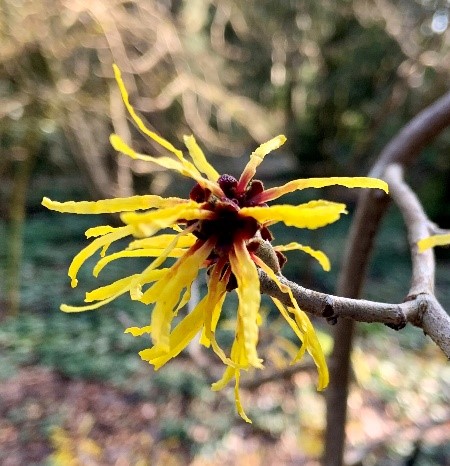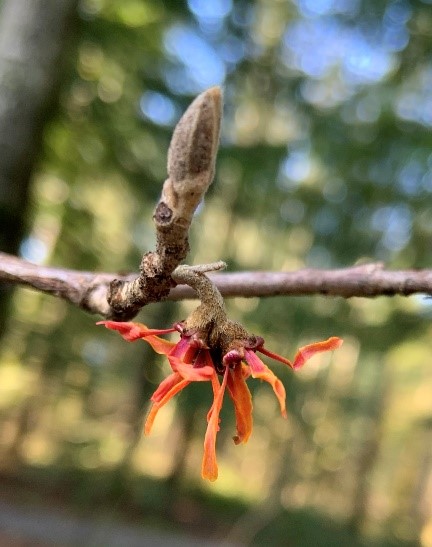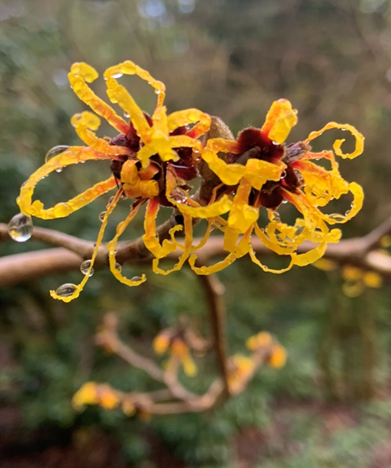What distinguishes witch hazels (Hamamelis) in the plant world is that flowers, fruits, and next year’s leaf buds can manifest simultaneously on the plant, in fact, the name Hamamelis means “together with fruit.” But around the Pacific Northwest, this genus of flowering shrubs may stand out for other reasons.
Around here, winter sometimes comes in February. Some years this might mean snow, others it could be cold and sunny, and others dark and dreary. But February also means the arrival of the witch-hazel flowers. The spider-like flowers with strappy petals come in an assortment of cheerful yellows, from pale yellow, bright lemon yellow, golden yellow to orange or copper tones. These bright, cheerful colors are just what we need in the wintery days of February.
The genus Hamamelis is made up of four species, two native to the United States (H. virginiana, H. vernalis) and one each from China (H. mollis) and Japan (H. japonica). The most popular American species (H. virginiana) is found over a wide area of the Eastern states, reaching as far west as Texas, and in Canada, from Ontario to Nova Scotia. Hamamelis vernalis, commonly known as the Ozark witch hazel, is limited in its distribution to the Ozark Plateau of Missouri, Oklahoma, Arkansas, and Louisiana.
The popularity of witch hazels jumped once the two Asian species were crossed to produce the sturdier Hamamelis x intermedia hybrids. Hybridization of these species has been going on since the 1930s at places like the Arnold Arboretum at Harvard University. The first cultivar to be named was ‘Arnold Promise’ in 1963, followed by ‘Diane’ in 1969, both of which can be found in the Woodland Garden.
Some of the more popular and commercially available witch hazel cultivars that can be found in the Woodland Garden are:
- ‘Arnold Promise’. Lemon yellow, sweetly fragrant flowers that appear in late winter to early spring. Its fall color, in shades of yellow, orange, and red, is unusual among yellow-flowered cultivars.
- ‘Diane’. The deepest red flowers of any cultivar, appearing in midwinter. Named after the daughter of famed Belgian growers Robert and Jelena de Belder.
- ‘Jelena’. Features luxurious copper flower colors, blooming in early to midwinter.
- H. mollis ‘Pallida’. This highly floriferous, citrus-scented yellow-flowered beauty is actually found in the Arboretum’s Perennial Garden instead of in the Woodland. Look for it in the center of the garden, the bright yellow flowers or buttery fall foliage help make it a standout.
- ‘Westerstede’. Lovely primrose yellow flowers that are elaborately curled and crimped. Blooms in later winter. Golden yellow fall foliage.
Other cultivars that can be found throughout the Woodland Garden are:
- ‘Orange Beauty’. Orange-flowered form that blooms in late January through March. Yellow, orange and red fall foliage.
- ‘Ruby Glow’. Dull red to pale coral-violet flowers with yellow to orange-red fall foliage.
- ‘Sunburst’. Bright lemon-yellow flowers.
- H. mollis ‘Goldcrest’. Sweetly-scented golden yellow flowers tinged with maroon at the bases of the petals.
- H. vernalis ‘Amethyst’. Lavender-purple flowers with grey-green foliage that turns brilliant scarlet in fall.
Given the winter appeal of witch hazels, finding a good site in the garden is worth some time and thought. Flower color and scent will be a factor in your decision but the shrub’s mature shape and winter silhouette should also be considered. In a home garden, you might want to plant one where it can be viewed from indoors. A background of evergreen shrubs will help show off the plant’s delicate and colorful blooms, especially the yellows. In a woodland garden, consider the amount of sunlight that will reach the plants. Witch hazels do best under deciduous trees, which allow winter sunlight through their bare branches. If the witch hazels are too shaded by evergreens that can become straggly and have fewer flowers.



